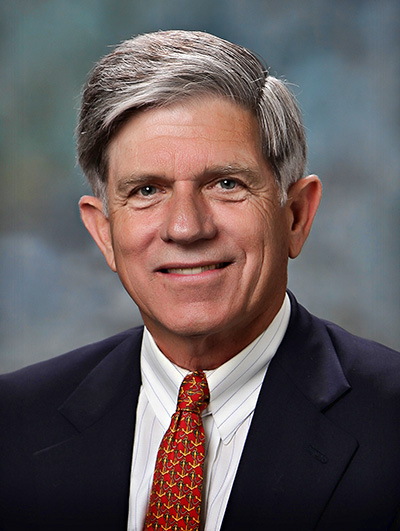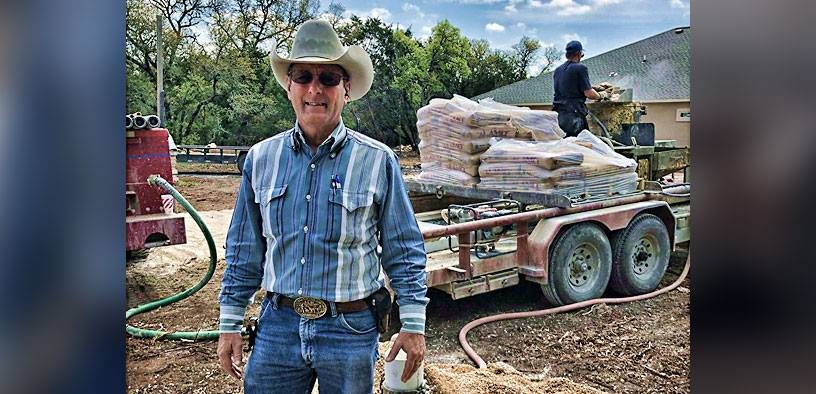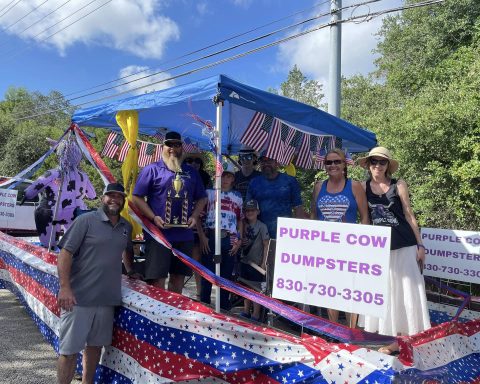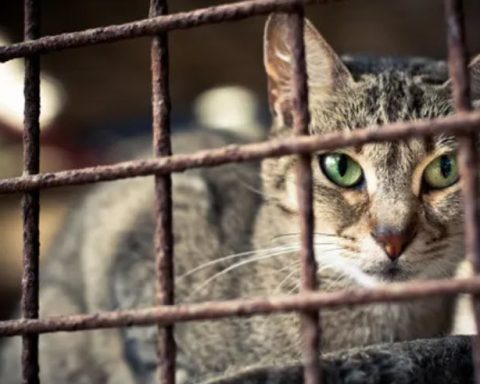A retiree in his 80s who has lived on two acres of land in Bulverde for 15 years is packing up and getting ready to walk away from his home.
His water well, which once produced 7 1/2 gallons of water per minute from the Trinty Aquifer, is dry. He pays a water hauler 13 cents per gallon to truck in just enough water to keep his household running. None of that water is used to irrigate his yard or fill his pool.
“Jim” agreed to talk to MyCanyonLake.com about his plight but only on condition of anonymity. He wants to protect his property’s resale value and is worried his address “might end up in someone’s database.”
Running Out of Water
Until late 2022 his 2,000-gallon water tank was always full.
“It happened to us fairly slowly,” said the 18-year Bulverde resident. “We blamed it on the pump and the system for a long time…We shut off all irrigation. Then it started going down more and more.”
He called a well expert who double-checked the submersible pump — it was working just fine — and advised Jim he isn’t the only person in the area with water issues.
Jim’s water hauler declined to be interviewed for this article but agreed with the well expert. Jim’s wife said the social media site NextDoor is lit up with similar tales of water woes.
“Apparently, it’s a big problem,” City of Bulverde Engineer Charles West told MyCanyonLake.com.
Jim called everyone he could think of looking for answers — Comal County Pct. 2 Commissioner Scott Haag, State Sen. Donna Campbell, the Public Utility Commission of Texas, the Bulverde Spring Branch Area Chamber of Commerce, Texas Water Company, Texas Water Development Board, the Federal Emergency Management Agency, the Guadalupe-Blanco River Authority and even his insurance company.
Everyone was polite and sympathetic but no one could help. They only offered suggestions about who else to call.
Jim said the Bulverde Spring Branch Area Chamber of Commerce seemed surprised to learn there was a shortage. His insurance agent appeared confused about the nature of his plight but said no to any future potential claims.
Now Jim’s wondering how much more of the current drought he’s prepared to withstand. Getting water hauled in isn’t cheap. Some water haulers require a minimum purchase of 3,000 gallons.
“We’re just going to have to lock the door and walk out and live somewhere else until something happens,” he said.
Answers from the TWDB?
Jim hopes someone will have an answer for him at Comal County Water Talk: Managing Our Groundwater from 5-6:30 p.m. Wednesday, Oct. 18 at Mammen Family Public Library, 131 Bulverde Crossing, Bulverde.
Chamber President Rhonda Zunker urges area residents who have water wells to attend the talk. Her office does not have any information about the condition of the Trinity Aquifer.
Natalie Ballew, director of the Groundwater Division of the Texas Water Development Board (TWDB), will discuss
- Groundwater 101
- Aquifers in Comal County
- Roles in Groundwater Management
- Groundwater Planning and How to Get Involved.
“From providing drinking water to sustaining our springs and rivers, groundwater is the lifeblood of Comal County,” Dripping Springs-based Hill Country Alliance said in an email urging supporters to attend the presentation.
“In the last year we’ve seen the drought threaten the health of our aquifers. At the same time, growth in the county means more people will rely on groundwater than ever before.”
Trinity Aquifer
The Trinity Aquifer extends across much of the central and northeastern part of the state. It’s one of the most extensive and highly used groundwater resources in Texas.
“There are several groundwater conservation districts that manage the Trinity Aquifer Group, and it behaves differently in each one due to different hydrological conditions geographically,” said Amanda Maloukis, general manager of the Trinity Glen Rose Groundwater Conservation District, which oversees parts of the Trinity Aquifer just south of Bulverde in Bexar County.
The aquifer supplies the vast majority of residential water wells in Comal County while the better-known Edwards Aquifer is the primary source of drinking water for San Antonio.

Larry Hull is board president of the Comal Trinity Groundwater Conservation District (CTGCD) in Spring Branch, which regulates the spacing of water wells and provides rules on well construction standards. The district cannot limit production, has no taxing authority and cannot place meters on private, exempt wells.
He said people frequently confuse the Trinity with the Edwards Aquifer.
When a reporter on a San Antonio TV station talks about the status of the J-17 well in Bexar County, they’re referring to the Edwards Aquifer. Local officials use that well’s water level to trigger or rescind drought restrictions.
The Edwards is a karst aquifer that replenishes itself quickly after heavy rains while the Trinity is a limestone aquifer that probably never fully recovered from the years-long drought of the 1950s, Hull said.
That natural disaster, still considered a ‘worst-case scenario’ by water planners, contributed to the state’s major demographic transition from farming and ranching to a largely urban Texas, according to TWDB.
If the Edwards Aquifer is like an underground lake, the Trinity is more akin to a dense sponge.
“You’ve got little caves and holes, you can see where the cracks go down,” Hull said. “That’s pretty typical of what it looks like all the way down the bottom of the formation. It’s a solid limestone formation.”
When it rains, less than 10% of the rainfall actually makes it down to the aquifer’s water-bearing level. It would take between two to three years of drenching tropical storms and heavy rains to actually “restore” the aquifer to near-normal levels, experts say.
If you live in Canyon Lake and want to see what the Trinity Aquifer looks like, take a drive along FM 2722 and check out the cliffs or cutouts at the top of the big hill near Stahlmann’s at Bear Creek-Farm Stand and Pecans.
A typical Trinity formation also can be seen in other areas along the highways that are cut through the hills like the ones on FM 306, Hull said.
About the CTGCD
The district’s mission is to maintain the Hill Country way of life by conserving, protecting and preserving the Trinity Aquifer’s groundwater resources.
This includes:
- Proactively managing and protecting groundwater resources
- Conducting research on groundwater availability, quality, water levels and use
- Identifying issues before they become problems
- Conducting public outreach activities to inform county residents about research findings and meetings
There are two types of water wells, “exempt” and “non-exempt.” Wells are exempted from paying fees to CTGCD if they are residential or used for livestock. Non-exempt wells are commercial wells capable of pumping more than 17.36 gallons of water per minute or 25,000 gallons per day.
According to CTGCD, the average household uses about 400 gallons of water per day. A swimming pool that is 15 by 30 feet and six feet deep holds approximately 20,250 gallons of water.
Wells Going Dry
Hull has a lot of sympathy for residents like Jim.
He lives on a ranch that overlooks the Guadalupe River in Spring Branch. His family bought the land in 1948. He remembers swimming in the river as a child prior to the drought of the 1950s and feeling the cold water from springs.
These springs no longer feed the Guadalupe River due to the declining level of the Trinity Aquifer and the lack of adequate recharge. The Guadalupe River currently is more or less dry from Comfort to Canyon Lake.
Now Hull’s own water well is drying up in the drought, and like Jim, he has some nearby neighbors who haven’t had any issues with their wells.
His cows use 50 to 100 gallons of water per day and sometimes he moves them to a different part of his pasture so a shallower well can take the strain off the well that’s drying up.
A Capricious Aquifer
The Trinity Aquifer’s a mystery.
“You can have a well that only produces half a gallon per minute and another well 150 feet away that is giving you 10 gallons a minute,” said Comal County Pct. 4 Commissioner Jen Crownover.
“For sure we know that (Bulverde) area is not a generous producing area of the Trinity Aquifer traditionally,” said Comal County Pct. 1 Commissioner Donna Eccleston. “They’ve had to go far deeper on that end.”
H.L. Saur, CTGCD’s general manager, got into the well business back in the 1970s. He remembers telling his wife that western Comal County would never repopulate after the drought of the 1950s.
“The fact of the matter is that it’s not an unlimited supply,” Hull said. “It’s not an underground lake like the Edwards Aquifer. The Trinity wells go dry. After the drought of the 1950s, our well went dry that was drilled to about 100 feet with the pump at a depth of 80 feet. We drilled down to about 300 feet with the pump located about 280 feet below the land surface, We’re about to go dry in the next few months. It’s just as simple as that. Not only are wells going to go dry but there’s no immediate likelihood that they’re going to recover.”
Although he can afford to drill another well, a lot of people can’t and many drillers are asking potential customers whether they want to gamble $30,000-$40,000 to drill a well that might not produce.
“That’s pretty discouraging,” Hull said.
County’s Hands Are Tied
Crownover said there’s little the county can do to stop the overwhelming growth that’s contributing to the depletion of the aquifer.
“The county has zero authority over any of this,” she said. “If wells have to be permitted, yes, that goes through the CTGCD.”
Developers are required to produce availability studies on all proposed new subdivisions, and once those are approved by the Texas Commission on Environmental Quality (TCEQ) or other authorities, the county cannot stop new subdivisions from going up.
Crownover said CTGCD is structured differently from that of at least one nearby county, which used its GCD to force developers to increase lot sizes in order to reduce water consumption.
How Much Water’s Left?
No one knows how many wells in Hull’s part of Comal County are drying up or whether dozens of social-media accounts are anecdotal or real.
Even if they did, they wouldn’t be able to tell you how much water’s left in the aquifer.
Average yields in the Trinity Aquifer in the Hill Country are about 250 times lower than average yields in the Edwards (Balcones Fault Zone) Aquifer immediately to the south, according to the TWDB.
“Lower yields combined with water-level fluctuations and greater pumping decrease the reliability of the Trinity Aquifer in the Hill Country as a source of water in times of drought,” predicted a report from 2000 that calculated groundwater availability through 2050.
CTGCD was formed in 2015 by Texas House Bill 2407, which made it possible for the first time for a governmental entity to collect reliable data about the number and depths of wells in Comal County’s section of the Trinity. There isn’t much information about anything drilled before then, although TWDB has some data.
One of the reasons CTGCD was formed was to have the ability to collect critical data needed to preserve and protect the aquifer, Hull said.
“Our GCD has only been around since 2015,” said Crownover, who monitors the wells on her property. “We’re only now getting a handle on establishing data points.”
Complete data may be impossible to obtain. Among other things, some property owners have relied on water haulers for years to meet their water needs.
“While water haulers are very visible when they pull water, the amount they use across the service area is about three percent of the total population,” said Larry Jackson, Texas Water Company’s (TWC) director of Customer Service and Communications.
“Landscape irrigation and watering grass still account for 60 to 70% of consumption.”
Hull said he is aware of a few property owners who drilled additional wells for landscaping purposes or to keep their pools filled. Under Texas law, property owners have a ‘right to capture’ any water resources on their land, so he’s not in a position to do anything about it, although their homeowners associations could.
At a recent CTGCD meeting, citizens in attendance who are petroleum engineers asked the district for detailed technical information about the geological features of Comal’s primary water source.
Hull said CTGCD only has collected data on the depth of water in individual wells for about six years. This data is specific to a particular well and may not necessarily be representative of other parts of the Trinity or of other geological levels of the Trinity Aquifer Group.
“People are asking the CTGCD to referee, particularly about a neighbor who is watering their grass,” he said. “The CTGCD does not want to get involved in neighborhood disputes but will educate and even beg. We must solve this problem together now and even when it begins to rain again in order to give our depleted aquifer a fighting chance to recharge.”
If You Think This Drought Is Rough…
Hull said it’s possible property owners might develop a sudden penchant for serious conservation practices like not using water from the Trinity to water their lawns.
But if they don’t, the future is bleak.
“If we can get people to stop wasting water and to practice good conservation habits we might make it,” he said. “If population growth was stopped today and we continue to use water without regard to conservation or recharge the situation would continue to decline.
“After the 1950s everything was different. Springs stopped running and never started again,” Hull said. “The drought was so damaging. People started coming here from everywhere else acting like it’s San Antonio or Houston rather than a semi-arid region. We can fix this problem collectively if we all get our heads together and stop wasting it and begin serious water conservation practices.
“If you think this drought is rough, wait until the next one.”
Opportunities to Change Course
The Meadows Center for Water and the Environment Defense Fund (EDF) believes GCDs have an opportunity to change course and manage groundwater sustainably.
Statewide, Texas is losing groundwater at nearly the maximum sustained rate and that rate is likely to increase in coming years unless officials change course, said Dr. Robert Mace, executive director and chief water policy officer at The Meadows Center for Water and Environment and lead author of the report Five Gallons in a Ten Gallon Hat: Groundwater Sustainability in Texas.
Vanessa Puig-Williams, director of EDF’s Texas Water Program, said in a statement that groundwater conservation districts have the authority to steer communities and their economies in a more sustainable direction.
Potential solutions include the creation of management zones, drought triggers, production curtailments, and landowner incentives to keep water underground, she said.
Hull has a few more suggestions to add to that list, including rain-cachement systems and use of drought-resistant and native plants for landscaping.
“Local groundwater districts already have the power to protect their communities’ water supplies,” Puig-Williams said. “They simply need better data to inform decisions as well as the commitment to manage these essential resources in a more sustainable way.”
Buyer Beware
Meanwhile, West advises anyone purchasing property in the City of Bulverde to ask if the water well that supplies it has been tested.
“Even that is not 100 percent accurate,” he said. “There’s no failproof system that I’m aware of to make sure the well’s not fixing to go dry.”
Attorneys with the Texas Real Estate Commission (TREC) said no such thing as a “drought waiver” exists under Texas Property Code 5.008.
Sellers are required to disclose the source of their properties’ water supply, according to the code.
Hull said Section 8 of the Seller’s Disclosure Notice (Form TXR-1406) requires sellers to state whether “any portion of the property is or is not located in a groundwater conservation district.”
Section 4, he said, asks whether “the seller is aware of any item, equipment or system in or on the property (that is) in need of repair which has not been previously disclosed in this notice.”
“Whether lack of water or drought equates to a ‘defect’ of the well would be a question for the courts,” a TREC spokesperson Sierra Pizarro said in an email.
Texas law does require real estate brokers and agents to be geographically competent and TREC can take disciplinary action against license holders who:
- Fail to consider market conditions for the specific geographic area in which the service is provided
- Fail to disclose or misrepresent a significant defect known to the license holder
“Parties should consult a private attorney if they have questions or concerns related to this issue,” TREC said.
But back to “Jim’s” insurance agent.
Texas Department of Insurance spokesperson Ben Gonzalez said there’s no such thing as insurance against drought.
“There might be policies that would cover damage to your property caused by drought conditions, such as cracks in walls, but not for a lack of water. Even in the limited case of a drought causing property damage, many home insurance policies exclude damage caused by ‘earth movement.'”
“As always, there are exceptions and special policies so we would encourage your readers to contact their insurance agent or company to ask questions about what their specific policy covers,” he said.
Where the Trinity Aquifer is concerned, there are no easy answers.
“But we all must begin to conserve and allow our Trinity Aquifer to recharge,” Hull said.




